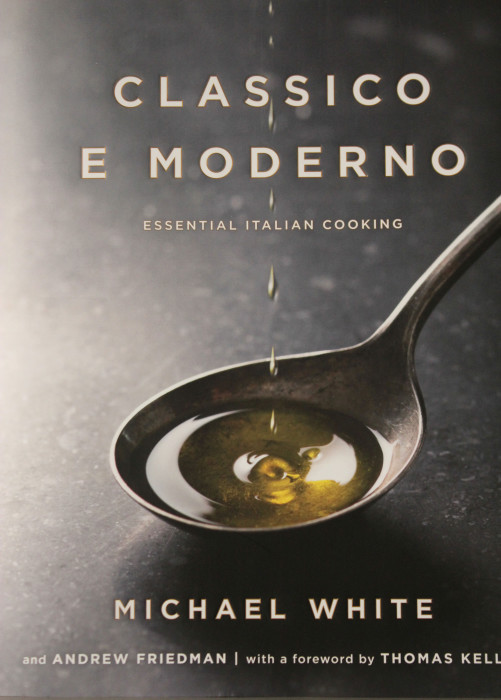Todays TBT cookbook is not terribly old, just five years, but it is so important I don’t want to wait a full ten years before reminding you about a significant work. Italian food is beloved by us all. We often think of it as “quick” food in contrast to the “slower,” more elegant French cuisine. This book destroys that viewpoints. Nothing can be superior to the fare you see here, fare that you can duplicate in your home kitchen. You might not become famous like Michael White. You will be thrilled with your kitchen efforts.
Upscale, gorgeous, coffee table cookbooks come in two varieties. Ones you can cook from and ones you can only admire, knowing too well that those beautiful pictures display food you could not possibly attempt on your own.
Michael White has rocketed to fame with his restaurants: six in New York City, two in New Jersey, one in Hong Kong and more to follow. His quality, in all the award-winning restaurants, is unsurpassed. Michael grew up in Beloit, Wisconsin, migrated to Chicago for serious restaurant experience at Spiaggi, and was infected with the chef bug. Some people grow up wanting to be President. Thankfully, he wanted to be Chef. He made his way to Europe, eating, working, and learning. He came to love French food, too, but for him Italian was the cuisine that inspired him. In Europe, he gained expertise and his wife.
Returning to the United States, he worked in restaurants and then founded his own restaurant group. Now, with incredible experience, Michael has written Classico e Moderno: Essential Italian Cooking. There are 250 recipes here, in 400 pages, and 4 ½ pounds!
This is really two books in one. The first half, Classico, is Michael’s tribute to the recipes he experienced and mastered during his years in Italy. These are, his versions, of the authentic recipes. Michael’s spin is wonderfully evident. He does not have simple Chicken Liver Pate. His version is Chicken and Duck Liver cooked with Marsala and anchovies.
From Piedmont, there is Baked Porcini Mushrooms with Egg, Radicchio and Parmesan. From Emilia-Romagna, he offers Parmesan Custards. The Ligurian Seafood Salad combines shrimp, mussels, and calamari with potatoes, string beans, grape tomatoes, olive and capers — salad as a complete meal.
And then there are the meatballs, following the tradition of Emilia-Romagna. These are Italian regional meatballs and as far from American as you could imagine. Here we use basic meat and add lots dried herbs to achieve flavor. In Michael’s version, it’s all about the meat: pork, mortadella and prosciutto are combined with milk, cheese, egg and bread crumbs.
As you turn the pages in the Classico section, you may find familiar names. But, as I have tried to show, Michael has packed this book with regional specialties:
- Garganelli with Prosciutto, Cram and Arugula
- Cavatelli with Lamb Ragu and Red Peppers
- Veal Stuffed Angolotti
- Pancetta-Wrapped Quail with Stewed Bell Peppers, Tomatoes and Onions
- Baby Peppers Stuffed with Cheese and Bread Crumbs
To study Classico is to take a culinary tour of Italy, exploring regions and restaurants. And getting a stronger sense for the pure, simple concept that is classic Italian cooking.
Which leads us to Part 2 of the book: Moderno.
How do you know you are in Moderno? It’s easy. First, they changed the fonts for the recipe titles. Sans Serif and ever so slightly italicized, you have entered a new world. The recipe titles tell you that. So do the pictures.
Moderno takes you on a tour, not of Italy, but Michael’s creative spirit — okay, creative genius. Here are some sample ideas:
- Salad of Raw Mushrooms, Charred Radicchio, and Pistachios
- Pan Fried Soft Shell Crabs with Prosciutto and Melon
- Raw Tuna with Radicchio and Grapefruit
- Potato and Tuscan Kale Agnolotti
- Spaghetti with Crab and Sea Urchin Roe
- John Dory with Crab and Zucchini Flowers
- Fennel-Crusted Tuna with Bean Puree and Crispy Pickled Onions
What has happened here is complex. Creativity, the availability of a full spectrum of ingredients, and the passion to experiment have all merged to forge these recipes. If you compare the photographs of these dishes with traditional fare of Classico, the distinction is clear: family fare versus Spartan and gloriously plated “New Food.” If anything, Classico e Moderno could serve as an encyclopedia for the culinary explosion of the past two decades. More ingredients in unexpected combinations that are plated as works of arts as much as a meal. The contrast is exceptional and beautifully presented here.
So, is this a coffee table cookbook? One you look at, but cannot cook from, too hard, too complex, too arty? In a word, no. In particular, Michael’s wizardry in the Moderno part has been carefully written into recipes for those of us with more modest culinary talent. Suzen took a stab at Pork Loin with Chickpeas and Ricotta Salata. The taste was inspiring: we opened a second bottle of wine. I’ll post a picture and the recipe later this week.
All the recipes here, in both Classico and Moderno, are ready for you. Yes, the ingredients list will stretch to 15-20 items. This is Italian cooking, so what did you expect. But, the instructions for each recipe are truly short, direct, easily followed, and will take you from a counter filled with goodies to a plate you will be proud of. Be prepared for that second bottle of wine.
If you are a foodie, if Italian is your passion, then Classico e Moderno could not be more highly recommended.
[My apologies to Thomas Keller for truncating his name when I cropped the image above. Look, I came to Per Se, I ate at Per Se, and I am dying to return.]

